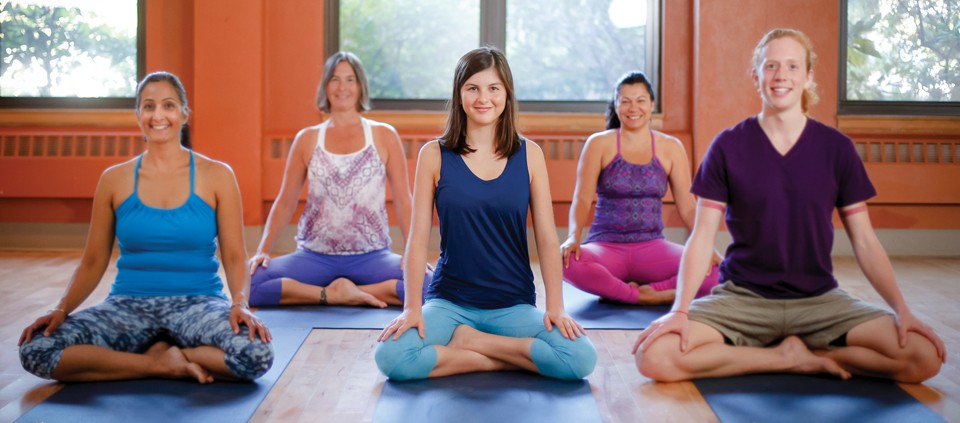A Is for Asana, B Is for Breath: The Impact of Yoga in Schools

“The practice of meditation leads to mental concentration. The very essence of education is concentration of mind, not the collection of facts. If I had to do my education once again, I would not study facts at all. I would develop the power of concentration and detachment.”
—Swami Vivekandanda
Stress is taking a toll on the health of our young people. According to the American Psychological Association, children as young as eight years old are reporting that they experience physical and emotional health consequences associated with stress. Among the challenges faced by children and adolescents are developmental, family, social, academic, and societal stressors; ADD and ADHD; physical issues, including obesity and diabetes; and mental-health challenges, such as depression, anxiety, and substance abuse. There is a clear need for tools that improve kids' and teens' social-emotional learning and self-regulation.
Yoga is one such tool. Multiple studies on yoga’s impact on adolescents show that regular practice increases self-esteem and mental and physical well-being, strengthens coping mechanisms and self-regulation skills, reduces anxiety, and improves mood. Qualitative data collection reveals that adolescents are less anxious and sleep better after doing yoga; their self-awareness and ease in their body increase; and their worldview begins to shift toward a more positive alignment. Yoga might even decrease adolescents’ willingness to smoke cigarettes, according to a recent study conducted in collaboration with Kripalu and funded by the National Institute on Drug Abuse.
Research on Kripalu Yoga in the Schools
Kripalu Yoga in the Schools (KYIS) is an evidence-based outreach program consisting of three modules that instruct adolescents in key self-management tools and techniques, such as postures, meditation, breathing practices, and relaxation, which enhance their ability to learn and expand their capacity to productively navigate life’s challenges. The Kripalu Yoga in the Schools Teacher Training has graduated more than 155 KYIS teachers, who have in turn educated thousands of adolescents in public, charter, and rehabilitation schools in dozens of districts across the country and the world. As Kripalu’s Reseach Director, I have led a number of studies on the impact of the KYIS curriculum on various student populations.
A 2012 study in a high school setting showed that anxiety levels and mood improved among students in the yoga class, while these measures worsened in a control group that attended PE classes rather than yoga. In a 2013 study of ninth and tenth graders, students reported improved self-image, reduced stress, better management of negative emotions, more optimism, and increased social cohesion with family and peers. In addition, KYIS research from 2015 that looked at how yoga practice affects students’ grades indicated that yoga may have a protective effect on academic performance.
Another study, published in the journal Contemporary School Psychology in 2015, compared the effects of a single yoga class versus those of a single PE class. Forty-seven high school students completed self-report questionnaires assessing mood and affect immediately before and after participating in a single yoga class and, one week later, a single PE class. Participants reported significantly greater decreases in anger, depression, and fatigue from before to after participating in yoga compared to PE. These results suggest that school-based yoga may provide unique benefits during the tumultuous years of childhood and adolescence.
Long-Term Benefits on Multiple Levels
The economics support bringing yoga to more teens. Spending $1,000 to put an adolescent through a yoga training program will lead to a transformation of their behavior, a reduction in their stress levels, and an improvement in their mind-body awareness. These changes, in turn, allow them to make better lifestyle choices; they are not driven to dysfunctional behavior due to unmanaged stress, and they gravitate toward healthy behaviors. Perhaps, for the first time in their lives, because of yoga, they are becoming aware of how they feel, and learning to engage in behaviors that make them feel better. Alternatively, in our current system, the unabated lifestyle risk factors will cost $100,000 for a quadruple bypass 20 years later.
That’s why bringing yoga to kids has such huge benefits: When you give children and adolescents the means to cope with stress and increase mind-body awareness, you’re providing them with skills that will ultimately affect not only their mental and physical health, but also their quality of life—potentially for the rest of their lives. As research continues to validate the positive impact of yoga practices, we will hopefully begin to see yoga increasingly implemented within our educational and healthcare systems, leading to a global transformation in our society’s health and functionality.
© Kripalu Center for Yoga & Health. All rights reserved. To request permission to reprint, please e-mail editor@kripalu.org.
Sat Bir S. Khalsa, PhD, is associate professor of medicine at Harvard Medical School, editor-in-chief of the International Journal of Yoga Therapy, and chief editor of the medical textbook The Principles and Practice of Yoga in Health Care.
Full Bio and Programs